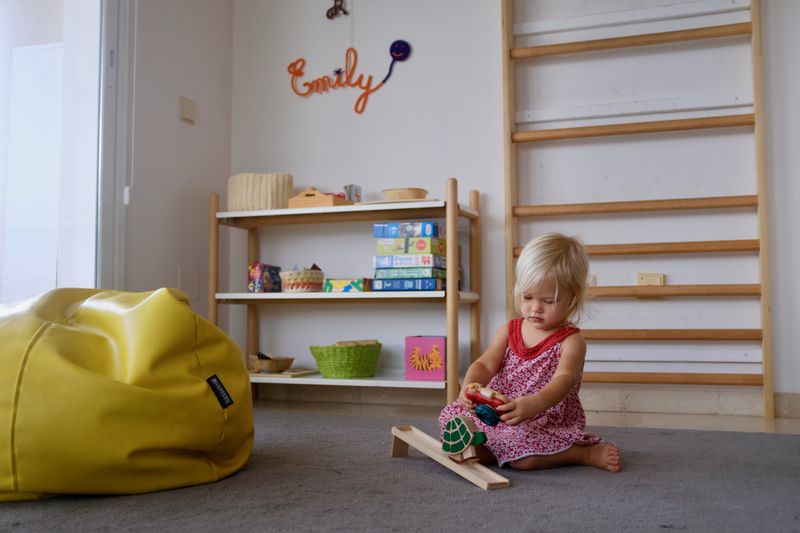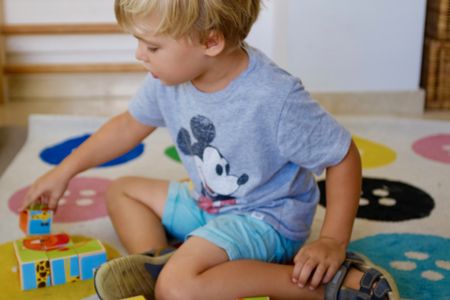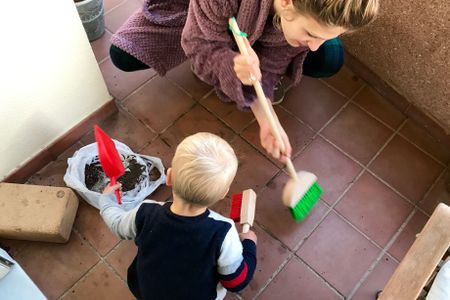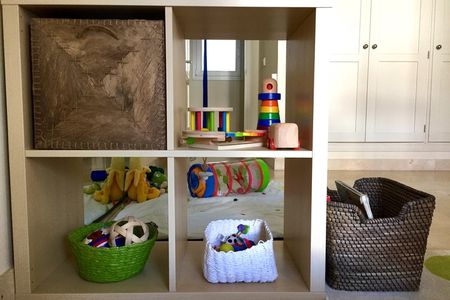Teaching your kids to tidy up is not *that* hard
Our apartment is not always tidy the way you see it in pictures. But I’d say, more often than not it’s not messy. We all contribute to keep it clean, especially the kids (I would actually say, and Alex would back me on this, I’m the messiest of the gang, oops!).
Oliver and Emily love order: actually every kid loves order—trust me, even yours—because young kids have a natural tendency for order. We parents simply need to nurture it by giving them the tools.
These are the “tools” that worked for us in our house and I feel like sharing them because they’ve worked twice and Oliver and Emily are VERY different children:
- We have a very limited selection of toys, which for me is the key to success.
- We have an even smaller selection of toys out to be used. I keep about 5-6 toys out per child, or less now that Oliver and Emily start enjoying the same toys.
- All the toys that we don’t use live in a closet.
- All the available toys are tidily on display on shelves. I usually keep puzzles in the box; for toys with lots of pieces (and a board), I put the pieces in a bowl on the shelf (and the bowl on top of the board, so they use it as a tray when taking a toy from the shelf).

- We usually try to use one toy, and put it back on the shelf before taking another one (just like in school).
- I rotate toys on the shelves when: 1. I remember (sometimes it takes a while); 2. Kids start making a mess when playing, which in my opinion means they’re not interested anymore; 3. They ask me for a toy that is in the closet (in which case we swap it for one on the shelves).
- We AVOID boxes and baskets: it might seem they help keep the room tidy, but they actually promote chaos. When a kid looks for a toy that lives in a box, he usually ends up turning the box upside down, thus making a mess that will probably feel too overwhelming for him to tidy up.
- Our play area is delimited by a carpet (ours is 2x2m), which helps to contain the mess.

How did you teach your kids to tidy up?
I get this question a lot. The answer might disappoint you, but the truth is: I never taught them. Since they were very young, every time we played with them, we followed ourselves the rule “put the toy back before taking a new one”: just like that, day after day, we created the habit spontaneously and, because we chose a Montessori school, the habit got reinforced there.
The other day, I came back from putting Emily down to sleep for her nap, and Oliver had tidied all his toys by himself. He told me, “I cleaned up everything. We have to take one material and then put it back before taking the next one, like in my school. Emily made a mess!”. The mess was three toys out at the same time (and yes, he often calls toys “materials” and play “work”).

What do you do when they refuse to tidy up?
This is always the tricky part: “but my kid refuses to tidy up!”. I hear it a lot!
When they forget, I remind them (even if they have already taken a new toy out).
If they still refuse to do it, I simply start myself and ask them to help me (which they usually do, even just one or two pieces).
If the situation gets out of control—it does happen—and all the toys from our shelves are on the carpet, I help them. Kids usually feel overwhelmed when they have to tidy up a big mess (which is why putting away one toy before taking another one works so well!), and if we ask them to tidy up, they will ignore us and we’ll end up in a power struggle. If we offer our help, instead, they will most likely accept it because they prefer order.
These are typical sentences I use—now that Oliver is bigger, verbal help is sometimes enough:
“Would you like me to help you tidy up?”
“I tidy up this toy, and you tidy up that one”
“Can you pass me all the pieces from that toy so I can put them in the bowl?”
“You can start from this toy, put away all the pieces in that basket, and put the basket back on the shelf”
When Oliver was younger, saying “If you don’t want to tidy up, then I will” would usually trigger his reaction to do it all by himself, but that definitely doesn’t work anymore ;-)
Now, understanding, empathy, help and simple instructions are what works for us in most situations.
No punishments or rewards, just feedback
My feedback
I try to never threaten or punish Oliver if he doesn’t clean up, and I definitely never reward him for cleaning up (I do thank him, though).
In his periods of untidiness (that usually coincided with stressful times in his life, beginning of school, coming home from a trip…) or when he refuses to clean up for many days in a row, I usually put away his toys in the closet (at some point we had only Duplos out to use). You might see this as a punishment, but for me it’s removing the overwhelming element of playing: less toys, less mess, less frustration when tidying up.
I usually put them back on our shelves gradually, when I think it’s time or when he asks for them (and I’m usually surprised of how long he can go without toys, just using his imagination to play).
The feedback of the environment
This happened only a few times, but it worked like magic.
Oliver had forgotten to tidy up and some of the toys that he had left out broke. We stepped on them, Colbie got a hold of them, Oliver ran over them while taking his bike out. It was sad, but it was a great lesson, and 100% provided by the environment.
I wouldn’t probably break his toys on purpose just to teach a lesson, but if I were desperate for solutions, why not? The end justifies the means, right? ;-)
Can I teach my kids now that they're older?
Kids live in the now, they have an amazing capacity for adapting to new situations and creating new habits. I think that by making a change in your environment (having less toys available, getting rid of boxes and baskets) and creating a new habit of putting away one toy before taking a new one is enough to “teach” them to play with their toys in a tidier way.

Sometimes, with toddlers, it’s usually enough to lead the way with our example; with older kids I have no experience, but it might work talking with them, explain the problem, brainstorm about solutions, and customise a reasonable habit that everybody feels comfortable with.
And always, always stay clear of extremes. Flexibility is motherhood best tool! Lately Oliver wants to take out all his puzzles and do them all on the carpet… why not?








